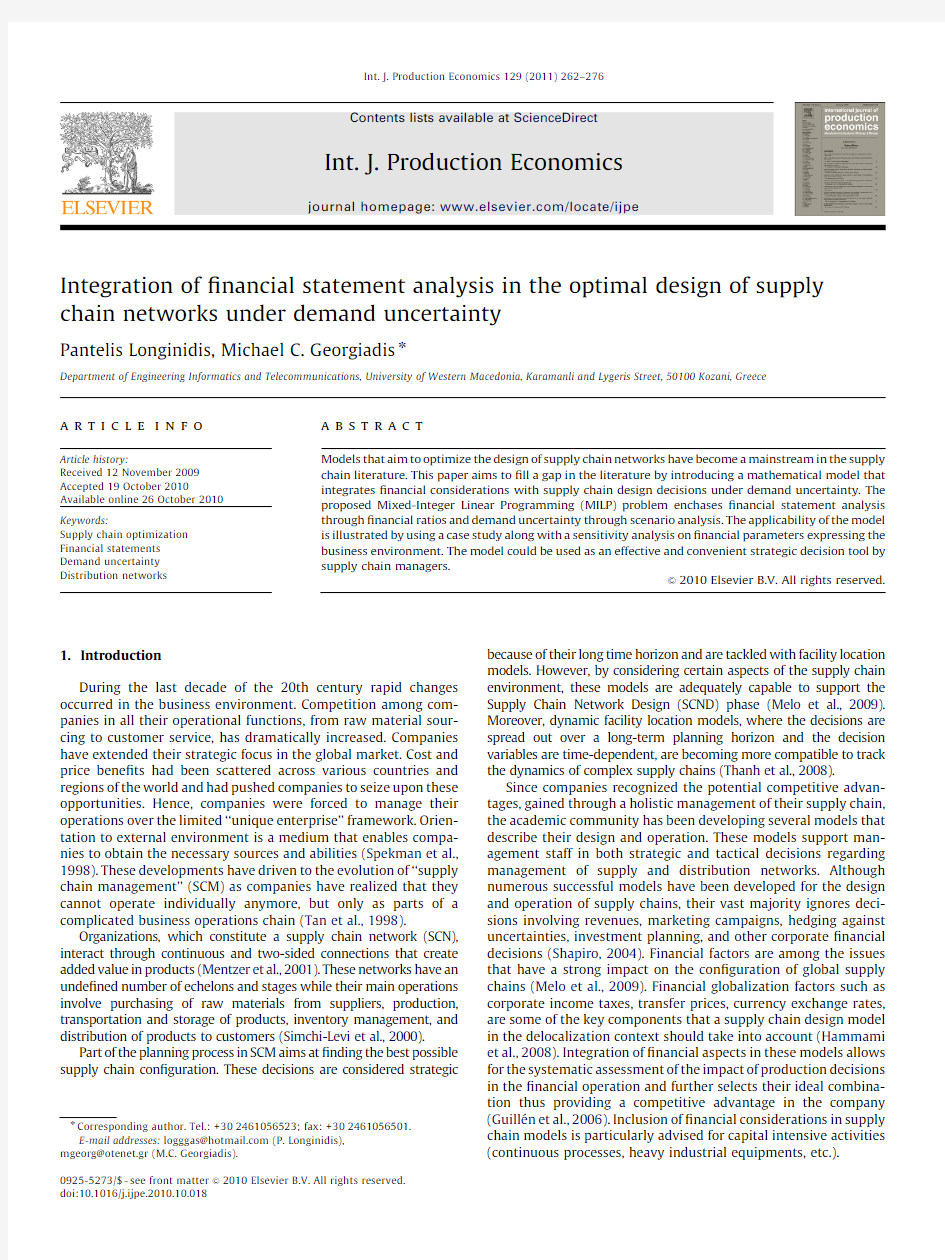
财务报表分析外文文献
- 格式:pdf
- 大小:138.95 KB
- 文档页数:3


Integration offinancial statement analysis in the optimal design of supply chain networks under demand uncertainty
Pantelis Longinidis,Michael C.Georgiadis n
Department of Engineering Informatics and Telecommunications,University of Western Macedonia,Karamanli and Lygeris Street,50100Kozani,Greece
a r t i c l e i n f o
Article history:
Received12November2009
Accepted19October2010
Available online26October2010
Keywords:
Supply chain optimization
Financial statements
Demand uncertainty
Distribution networks
a b s t r a c t
Models that aim to optimize the design of supply chain networks have become a mainstream in the supply
chain literature.This paper aims tofill a gap in the literature by introducing a mathematical model that
integratesfinancial considerations with supply chain design decisions under demand uncertainty.The
proposed Mixed-Integer Linear Programming(MILP)problem enchasesfinancial statement analysis
throughfinancial ratios and demand uncertainty through scenario analysis.The applicability of the model
is illustrated by using a case study along with a sensitivity analysis onfinancial parameters expressing the
business environment.The model could be used as an effective and convenient strategic decision tool by
supply chain managers.
&2010Elsevier B.V.All rights reserved.
1.Introduction
During the last decade of the20th century rapid changes
occurred in the business petition among com-
panies in all their operational functions,from raw material sour-
cing to customer service,has dramatically panies
have extended their strategic focus in the global market.Cost and
price benefits had been scattered across various countries and
regions of the world and had pushed companies to seize upon these
opportunities.Hence,companies were forced to manage their
operations over the limited‘‘unique enterprise’’framework.Orien-
tation to external environment is a medium that enables compa-
nies to obtain the necessary sources and abilities(Spekman et al.,
1998).These developments have driven to the evolution of‘‘supply
chain management’’(SCM)as companies have realized that they
cannot operate individually anymore,but only as parts of a
complicated business operations chain(Tan et al.,1998).
Organizations,which constitute a supply chain network(SCN),
interact through continuous and two-sided connections that create
added value in products(Mentzer et al.,2001).These networks have an
undefined number of echelons and stages while their main operations
involve purchasing of raw materials from suppliers,production,
transportation and storage of products,inventory management,and
distribution of products to customers(Simchi-Levi et al.,2000).
Part of the planning process in SCM aims atfinding the best possible
supply chain configuration.These decisions are considered strategic
because of their long time horizon and are tackled with facility location
models.However,by considering certain aspects of the supply chain
environment,these models are adequately capable to support the
Supply Chain Network Design(SCND)phase(Melo et al.,2009).
Moreover,dynamic facility location models,where the decisions are
spread out over a long-term planning horizon and the decision
variables are time-dependent,are becoming more compatible to track
the dynamics of complex supply chains(Thanh et al.,2008).
Since companies recognized the potential competitive advan-
tages,gained through a holistic management of their supply chain,
the academic community has been developing several models that
describe their design and operation.These models support man-
agement staff in both strategic and tactical decisions regarding
management of supply and distribution networks.Although
numerous successful models have been developed for the design
and operation of supply chains,their vast majority ignores deci-
sions involving revenues,marketing campaigns,hedging against
uncertainties,investment planning,and other corporatefinancial
decisions(Shapiro,2004).Financial factors are among the issues
that have a strong impact on the configuration of global supply
chains(Melo et al.,2009).Financial globalization factors such as
corporate income taxes,transfer prices,currency exchange rates,
are some of the key components that a supply chain design model
in the delocalization context should take into account(Hammami
et al.,2008).Integration offinancial aspects in these models allows
for the systematic assessment of the impact of production decisions
in thefinancial operation and further selects their ideal combina-
tion thus providing a competitive advantage in the company
(Guille´n et al.,2006).Inclusion offinancial considerations in supply
chain models is particularly advised for capital intensive activities
(continuous processes,heavy industrial equipments,etc.).
Contents lists available at ScienceDirect
journal homepage:/locate/ijpe
Int.J.Production Economics
0925-5273/$-see front matter&2010Elsevier B.V.All rights reserved.
doi:10.1016/j.ijpe.2010.10.018
n Corresponding author.Tel.:+302461056523;fax:+302461056501.
E-mail addresses:logggas@(P.Longinidis),
mgeorg@otenet.gr(M.C.Georgiadis).
Int.J.Production Economics129(2011)262–276